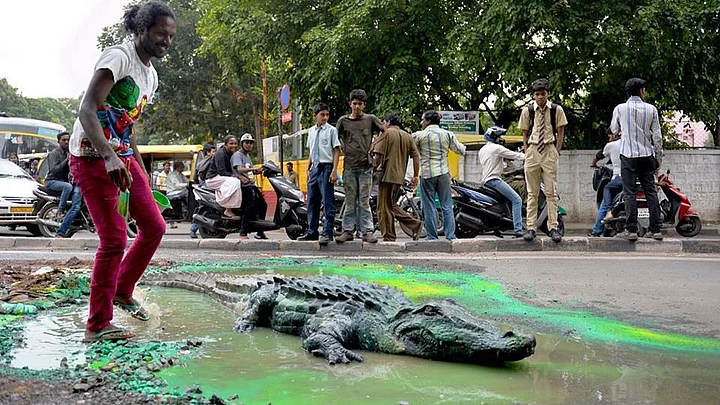Karnataka Chief Minister Siddaramaiah’s order to make Bengaluru pothole-free remains unfulfilled, even as the extended deadline comes to an end.
The deadline of 6 November was set by Siddaramaiah himself, and even on the last day, the Bruhat Bengaluru Mahanagara Palike (BBMP) was scrambling to fix the roads.
Bengaluru Mayor Sampath Raj admitted that as on 6 November, the repair work on potholes remains incomplete. Although he promised action against engineers who haven’t completed the work, the criticism against the BBMP doesn’t stop at the delay in completion. Unevenness of the roads which were repaired under the drive, and private and government agencies digging up repaired roads, has irked several citizens of the city.
The Big Drive
After five pothole-related deaths were reported in Bengaluru, the government announced a pothole filling drive on 10 October. The BBMP was asked to identify potholes in each ward of the city and submit a detailed list. As per the report, the city had over 15,000 potholes, and the Chief Minister ordered them to be filled within 15 days.
Contracts were issued on a war footing and the imported ‘python’ pothole filling machines were pressed into action. As per the initial deadline, the work was to be done by 25 October. As the deadline was getting closer, the Mayor wrote to the Chief Minister claiming the heavy rains in the city stalled the refilling process, and the BBMP needed 10 more days.
The Unfinished Job
On 6 November, when the second deadline came to an end, the BBMP once again shrugged its shoulders. Speaking to The Quint, Mayor Sampath Raj admitted that all not all potholes in the city were filled.
Around 95 percent of the potholes on major roads and 98 percent potholes in the wards have been filled, the Mayor claimed.
This data was, however, based on information provided by contractors. “We will be conducing inspections across the city to verify these numbers. If the potholes are found during inspection, action will be taken against the concerned BBMP engineers,” Raj added.
The claim of having filled over 95 percent of the potholes has been looked at with skepticism, as figures released on 4 November showed that a large number of potholes remained unattended.
Fresh Digging on City Roads
Even as the BBMP is struggling to fill the existing potholes, several private companies and government organisations continue to dig roads for ‘maintenance work.’
On Davis Road near Pulakeshinagar, days after the BBMP filled the potholes, part of the road was dug up for laying underground pipelines. “Even though we questioned the contractor, he said that he had obtained all the permissions from the BBMP. When we asked when the road will be repaired, he said it is the BBMP’s job,” said Thomas Kurian, a resident of the area.
The BBMP is facing severe criticism for how it asphalted the potholes as well. As a fresh layer of asphalt is applied on the potholes, several roads have become uneven. In some areas, minor accidents have even been reported because of the unevenness.
Not a Lasting Solution
Experts are not convinced about the effectiveness of the methods used for filling potholes.
There are two ways of filling a pothole – using a hot mix and a cold mix.
In the cold mix, an emulsion of jelly is used to fill the pothole. The jelly is pressed hard against the pothole, flattening the road’s surface. In the hot mix method, a mixture of jelly and asphalt, which is kept at a temperature of 100 degrees is poured over the pothole.
“It is known that the hot mix method lasts longer than cold mix. However, the BBMP opted for cold mix method in most of the areas because of the rain. So, we need to wait and watch how long this patchwork will remain,” said V Ravichandar, an urban expert.
Incomplete Promise and Political Implications
Despite the BBMP’s claims, a one-hour drive in Bengaluru will reveal that the pothole problem continues.
For the Siddaramaiah government, the potholes have not only caused an image problem among its citizens, but have also become a political tool for the BJP in its election campaign. The BJP, which began its campaign alleging lack of development in Karnataka, has been harping on the condition of the city’s infrastructure to prove its point.
Even the traffic police have pointed fingers at the BBMP for the traffic jam in the city, claiming bad roads have aggravated Bengaluru’s traffic woes. With the inspections expected to take place from Tuesday, 7 November, it is needed to be seen whether the government is serious about its promise of a pothole-free Bengaluru.
Finally, we leave you with a rap song created by a group of Bengalureans about the pothole problem in the city.
